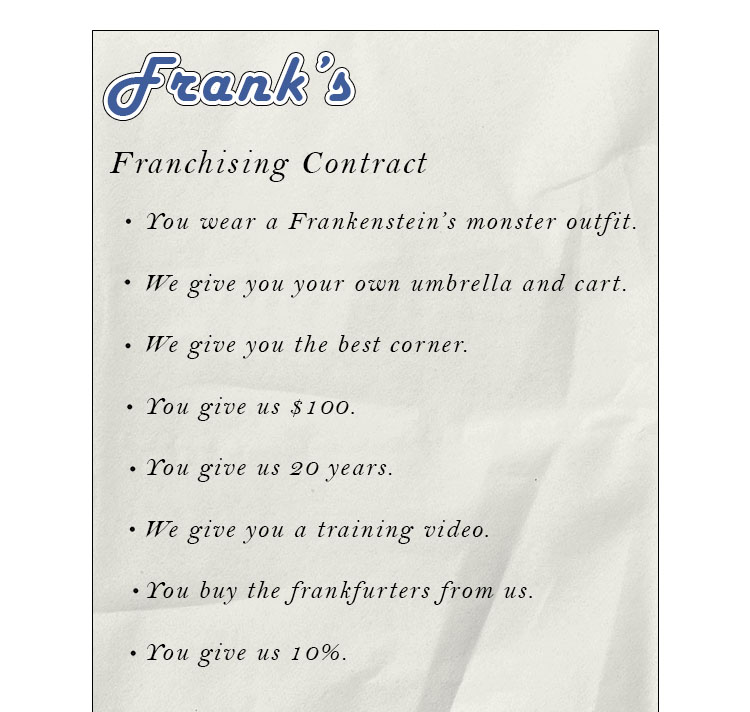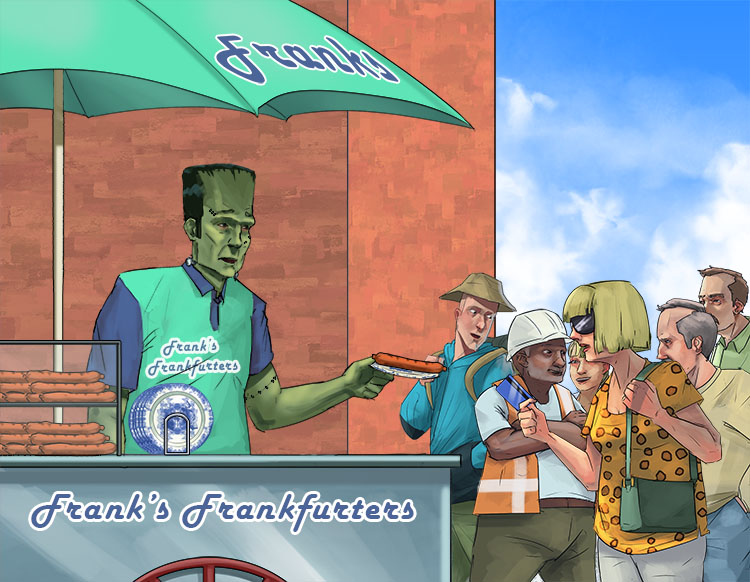franchising – the sale of the rights to use/sell a product by a franchiser to a franchisee
(Pronounced fran-chai-zing)
To remember what franchising means use the following mnemonic:
Selling frankfurters on China plates was surprisingly (franchising) popular, so I sold the rights to my idea.


The franchise business model involves an owner licensing their operations along with the product, branding and knowledge from a company (franchiser) in return for an initial upfront fee followed by ongoing costs and royalty payments. Many famous fast-food chains operate like this, such as McDonalds, Subway and KFC. This is an efficient method of expansion for a business that has enough demand, but careful oversight must be made to ensure individual franchisees are upholding the expected quality of service.
The franchise business model is not only limited to restaurants, but can include chains of convenience stores, automotive repair shops, gyms, and various other businesses.
Before starting a franchise, there are a series of steps to take:
1) Do your research – Before you even think of starting a franchise, it’s important to do research and figure out what type of franchise is right for you. There are many different types of franchise available, so it’s important to find one that aligns with your interests, skills, and financial resources.
2) Choose a franchise – Once you’ve done your research, it’s time to start narrowing down your choices and choose a franchise, keeping in mind the industry, the size of the investment and level of support. Once the chosen franchise has been contacted, it’s important to ask as many questions as possible about the business and the franchise agreement.
3) Submit a franchise application – Once you are sure that the franchise is right for you, an application must be submitted to the franchiser which they will review to decide whether you are a good fit for their system.
4) Negotiate the franchise agreement – If the franchiser approves your application, you’ll need to negotiate the franchise agreement. This is a legally binding document that outlines the terms of the relationship with your franchiser.
5) Fund your franchise – Starting a franchise can be expensive, so you’ll need a way to fund your business. Loans are the most common method used to raise capital amongst franchisees, but personal savings and private investors are also used.
6) Open your franchise – Once all the necessary funding is in place, a location is secured and the franchiser is working closely with you, the franchise can be opened. This is the most difficult section, as employees must be recruited and trained, the business must be marketed, and relationships with customers must be built.
Franchise Example: McDonalds
A McDonalds franchise works in the following way:
McDonalds make a 20-year agreement with one person only, who must complete the minimum 26-week training program and sign the agreement to become the franchisee. That person becomes the owner of that franchise site, but pays the franchisor (McDonalds) an upfront fee, a monthly fee, and a large percentage of the takings. As a franchisee, the person must have a fully functioning workspace, equipped and ready to run as a McDonalds restaurant. They will have to use McDonalds systems, trademarks, menus, equipment, methods, support and marketing. The franchisee must agree to operate the business according to the framework and requirements to ensure conformity to the McDonalds brand. Some franchisees grow to become multi-site operators. A franchise has to make a significant upfront financial investment of at least £100,000, but the rewards can be excellent. A potential franchisee has at least three interviews to pass before they are even considered for a position. Compared to the average franchise failure rate of 50%, McDonalds is a far more stable investment, with the average failure rate being 1.5%




